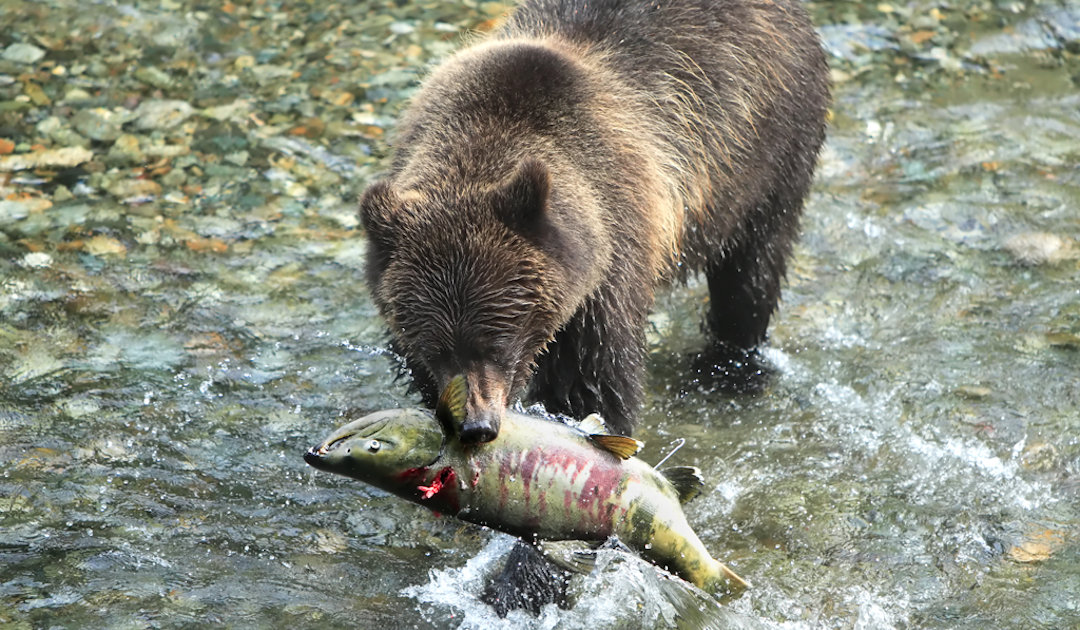
Salmon migrations in Alaska and other Pacific regions of the Arctic are among the highlights for animals and locals. Because the fish are an important part of the nutrient circulation when they die after spawning. But researchers are now sounding the alarm: the fish, which once showed pretty big sizes, become smaller and smaller when they arrive at their spawning grounds. According to the scientists, this has far-reaching consequences for nature and the economy.
The results of the scientists showed that in the past 60 years, the fish did not grow smaller, but migrated from the sea back to their spawning grounds earlier and earlier. Normally, salmon remain at sea for seven years on average, where they find enough food and grow until they make their way back into the creeks initiated by yet unknown trigger. Fishermen in Alaska noticed that the animals, which are of great importance to them, were getting smaller and smaller. “We saw a strong and consistent pattern that the salmon are returning to the rivers younger than they did historically,” explains the study leader, Professor Eric Palkovacs of the University of California Santa Cruz.

The team examined about 12.5 million catch data from four different salmon species from the past 60 years in Alaska, collected by the state Fish and Wildlife Agency. Chinook, coho, chum, and sockeye salmon were affected by the size reduction. However, analyses showed that the cause of the decline was not one factor alone, but several together, and the different species in different regions of Alaska were affected different levels.

“We know that climate drives changes in ocean productivity.”
Professor Eric Palkovacs, University of California, Santa Cruz
However, two of the factors were decisive for all four species and all regions: climate change and the increasing number of farmed salmon released into the oceans. “We know that climate drives changes in ocean productivity, and we see a consistent signal of climate factors associated with decreasing salmon size,” explains Eric Palkovacs. “Another consistent association is with the abundance of salmon in the ocean, especially pink salmon. Their abundance in the North Pacific is at historic highs due in part to hatchery production in Alaska and Asia, and they compete with other salmon for food.”

The consequences of this development do not only affect the salmon themselves, but go much further. Younger and smaller salmon have less breeding success, as the number of eggs and their quality also depends on the condition of the fish. Another consequence is the lower amounts of nutrients which the salmon return to the environment after their death. “Salmon go up into these small streams, and whether they are caught by predators or die after spawning, their nutrients are transferred into the forests and freshwater ecosystems,” explains Eric Palkovacs. “It’s a classic salmon ecosystem service, and the amount of nutrients they deliver depends on their body size.”


“For commercial fishers, smaller fish tend to fetch lower prices.”
Dr. Krista Oke, University of Alaska, Fairbanks
But it is not only nature that suffers from the consequences of smaller salmon. The loss of size also hurts economically. For many locals, salmon are an important part of their diet and income. “Smaller fish is a real problem for people who depend on salmon for their food and well being,” says Krista Oke, the study’s lead author. “For commercial fishers, smaller fish tend to fetch lower prices, and below a certain size they can’t be made into high-value products and might have to be canned.” In addition, smaller fish lay fewer eggs, resulting in fewer catches, fewer tourists who came to catch salmon and more planting of pink salmon to compensate for losses. The vicious circle continues to spin, just like the farmed salmon in their artificial swimming pools.

Dr Michael Wenger, PolarJournal
Link to the study: Oke et al (2020) Nature Communications 11, (4155) Recent declines in salmon body size impact ecosystems and fisheries, https://doi.org/10.1038/s41467-020-17726-z
More on the subject:





